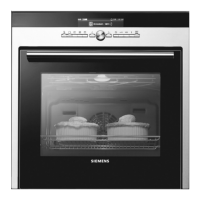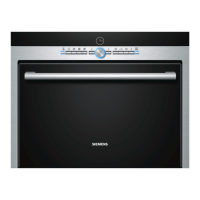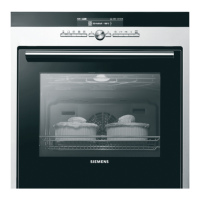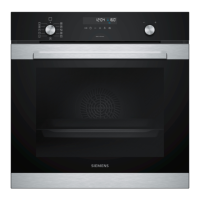24
Acrylamide in foodstuffs
Acrylamide is mainly produced in grain and potato products
prepared at high temperatures, such as potato crisps, chips,
toast, bread rolls, bread or fine baked goods (biscuits,
gingerbread, cookies).
Test dishes
These tables have been produced for test institutes to facilitate
the inspection and testing of the various appliances.
In accordance with EN/IEC 60350.
Baking
When baking on two levels, always insert the baking tray above
the universal pan.
Piped cookies: Food on baking trays that are placed in the
oven at the same time will not necessarily all be ready at the
same time.
German apple pie on 1 level: Place dark springform cake tins
diagonally next to each other.
Note: For baking, use the lower of the temperatures indicated
first.
Tips for keeping acrylamide to a minimum when preparing food
General
■ Keep cooking times to a minimum.
■ Cook meals until they are golden brown, but not too dark.
■ Large, thick pieces of food contain less acrylamide.
Baking With top/bottom heating max. 200 °C.
With 3D hot air or hot air max.180 °C.
Biscuits With top/bottom heating max. 190 °C.
With 3D hot air or hot air max. 170 °C.
Egg or egg yolk reduces the production of acrylamide.
Oven chips Spread evenly over the baking tray, in a single layer. Bake at least 400 g per baking tray
so that the chips do not dry out
Dish Accessories and ovenware Level Type of
heating
Temperature
in °C
Cooking time
in minutes
Piped cookies Baking tray 2
%
150-160 20-30
Baking tray 1
:
140-150 20-30
Baking tray + universal pan 3+1
:
140-150 25-40
Small cakes (preheat) Baking tray 2
%
160-170 20-30
Baking tray 1
:
150-160 20-30
Baking tray + universal pan 3+1
:
150-160 25-35
Hot water sponge cake (pre-
heat)
Springform cake tin on the wire rack 1
%
160-170 25-35
Springform cake tin on the wire rack 1
:
160-170 25-35
Double crust apple pie Wire rack+ 2 springform cake tins,
dia. 20 cm
1
;
170-180 70-80

